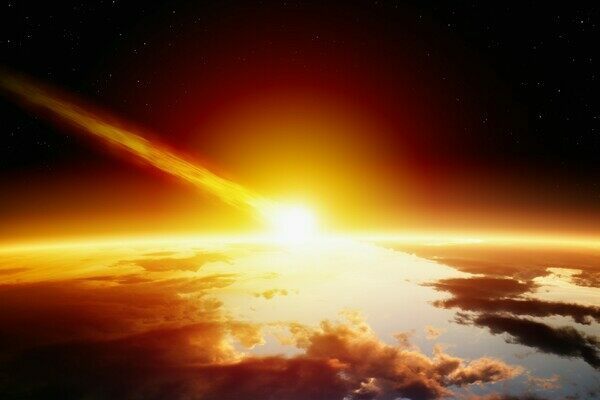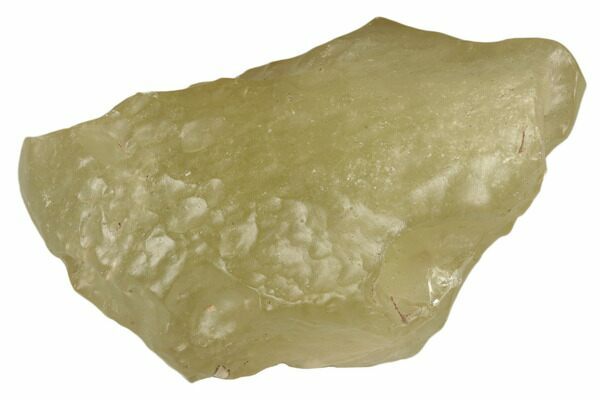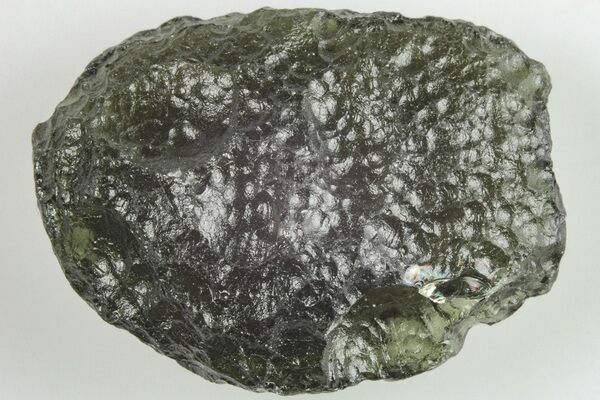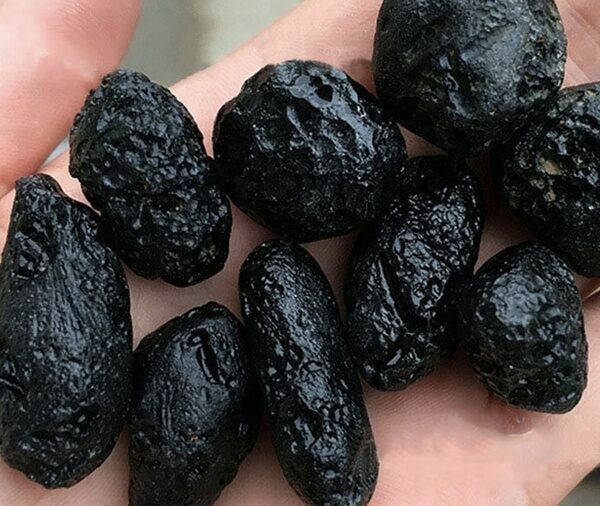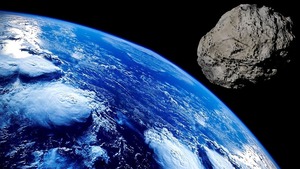What Is A Tektite?
Put simply, tektites are a form of natural glass that was formed via high velocity and extreme heat. The easiest way to satisfy these conditions is through extraterrestrial impact. They are often quite small, etched, and glossy black, though can be brown, yellow, or green. Tektites are evidence that the earth was once continuously under siege by outer space. These small chunks of impact glass have an atmospheric entry count of two. First is the initial impact followed by melt of surface material, then propulsion into the atmosphere, then re-entry, more melting/shaping and eventually a second impact with terra firma.
Tektites are formed over a few separate stages. The first and foremost of the stages is the initial impact of a meteorite with silica rich soil. The silica rich soil part is important, because it’s the melting silicates and terrestrial material that are ejected by the meteor impact that classifies tektites as tektites and not meteorites. During ejection the molten blob will begin to shape because of the interference with the atmosphere upon exit. It is before re-entry that the tektite begins the cooling process and will re-enter the atmosphere as a cool chunk of ejecta, except for some of the really large chunks that will retain heat. The first of the ejected material will re-enter at the highest speeds and the pressure alone superheats them again and begins the deformation/shaping process. These initial bodies are apt to scatter further away from the source crater than bigger chunks nearest to the impact that have reduced velocity and less variation in shape. Once the tektite touches down again, the surface of the Earth and any surrounding water etches the glass as it cools and is weathered. Moldavites are a great example of this phenomenon as they are so aggressively pocked and flattened.
The most widely accepted hypothesis suggests that tektites are created from high velocity, low angle impacts on a soft, water and silica rich surface. These conditions provide the best chance of propelling molten particulates into the atmosphere for re-entry, satisfying the parameters that categorize an impact glass as tektites.
A general baseline for establishing the scientific parameters that qualify a tektite are as follows. The source impact crater must exceed 10 km in diameter, produce 300 km wide strewn fields, and the fields must be at a distance over 200 km, but not in excess of 5,000 km (11,000 km if microtektites), from the impact crater. These are ridiculously specific parameters, but these hold true for all of the tektites that we are aware of.
Tektites are found in select locations across the globe, referred to as strewn fields. A strewn field is the area surrounding the initial impact crater that propagated the creation of the tektites. At this current juncture there are four universally accepted strewn fields, with a fifth that was recently described. These fields are, from largest to smallest diameter: the Australasian, the North American, the Ivory Coast, the Central European, and the Central American. A noteworthy addition is Libyan Desert Glass and the impact that created it. While the exact impact location is still unknown, the area that contains Libyan Desert Glass is certainly large enough to have originated from a 10 km wide impact crater.
The Australasian strewn field is the largest geologically (estimated at covering 10-30% of the Earth’s surface) and produces the widest variety of tektites. However it is the only strewn field where the source impact crater is yet unknown. It is the youngest of the strewn fields with tektites dating back over 790,000 years, and some scientists believe that human ancestors, Homo erectus, may have been living when the source meteorite hit Earth. There are four common tektites within this strewn field, Australites, Philippinites, Indochinites, and microtektites. Each of these tektites are categorized by the location in which they were found and the shape of the tektite. That said, most of these tektites have the teardrop, slashdown shape, though button shaped tektites are not unusual for Australites. Microtektites are found on the outer edges of the strewn field’s boundary. As the name implies they are much smaller than the average tektite and are usually found in deep ocean sediments around the source impact landmass.
The North American and Ivory Coast strewn fields have the second and third largest perimeter, respectively. They also represent the top and bottom ends of the pure-silica content of tektites. North American tektites–Georgiaites and bediasites–contain roughly 80% pure silica, where Ivorites contain 68%. Georgiaites and bediasites are linked to the Chesapeake Crater as a source impact crater. The Ivory Coast strewn field is the product of the Bosumtwi Crater in Ghana.
The Ries Crater in Germany and the Czech Republic is the source crater of the Central European strewn field which produces the ever popular moldavite. This pitted green, translucent tektite is by far the most sought after of all tektites and it's easy to see why. This glass is ridiculously interesting to look at. Especially because it can present in a wide range of greens with varying sizes of pits from erosion and re-entry.
The Central American strewn field is the most recently recognized tektite site. Atacamaites from this location are sourced from the Pantasma Crater. This strewn field is currently in the early stages of discovery as it was initially proposed as a legitimate strewn field in late 2019.
The shape of tektites are typically linked to the distance between the strewn field and the impact site. There are a plethora of factors at play in tektite shaping, but the two primary are size and velocity upon re-entry. Generally, larger post-impact ejecta won’t attain as great of heights as smaller bodies, but they will retain more heat over longer periods of time.
Sphere - These tektites are roughly spherical in shape and are thought to have formed nearest to the initial impact and are often found at the inner edge of the strewn field closest to the impact crater. They had less time at high temperatures to undergo any major changes in shape, aside from superficial rounding of the outer edges.
Flanged/Button - This variety of tektite looks a lot like buttons, where the outer edges hardened, while the inner projectile remained molten and was pushed through and up the outer ring by the air as it plummeted. These tektites begin re-entry as a sphere, but the insane velocity and pressure laterally compress them into misshapen plate-like forms.
Dumbbell (asymmetrical and symmetrical spheroidal splash form) - These molten objects spun on a central axis creating a dumbbell shape as they catapulted toward earth. When balanced, the centrifugal force will create an evenly symmetrical dumbbell shape. But when not evenly applied you will get an unevenly asymmetrical dumbbell shape. Dumbbell tektites are found with other splash form tektites in the middle of the strewn field.
Teardrop/Spindle (elongate spheroidal splash form) - Teardrop shaped tektites are often the result of the spinning force that creates dumbbell shaped tektites being too great for the central mass, so it splits in the middle and launches to earth like a spindle. These tektites appear toward the middle of the strewn field range as they undergo significant speeds, pressure, and forces.
Layered (Muong Nong) - Muong Nong tektites present in a layered form that is often heavily included with terrestrial minerals like baddeleyite. Layered tektites are found closer to the source impact crater and will be less misshapen or have less variation in shape than those that re-enter at the outskirts of the strewn field. Compositionally, these tektites show the greatest amount of both extraterrestrial and native Earth minerals.
Microtektites - Microtektites are the smallest of all the terrestrial material ejected upon impact. Often these will take almost any form as they are essentially at the whim of the winds after re-entry. These tektites typically demarcate the outer edge of the strewn field and are usually found in ocean sediment.
The name tektite spins out of the ancient Greek word, tektos, meaning “molten”. An apt name for a glass that is formed through extreme heating. Archaeological evidence indicates the presence of tektites in the regalia and tools of ancient cultures, dating back to between 4,000 and 6,000 B.C. In A.D. 950, Liu Sun named these small chunks of glass, Lei-gong-mo, which translates to “Inkstones of the Thundergods”. While this awesome moniker didn’t stick, it was the first mention of the material in written history. It wasn’t until 1788 that tektites appeared in scientific literature though they were incorrectly labeled as volcanic glass for about 110 years before they were given the name tektite and were first believed to be shaped by high velocity airflow. From then on, tektites have been the subject of many debates and studies. Of late, the search for the origin of the Australasian strewn field and the Libyan Desert Glass impact site have been the hottest topic.
Because they can be similar in appearance, tektites and volcanic glass are often confused for one another. Despite their appearance, the two are actually quite different. The multiple molten stages of a tektites formation leave them with very low water content in their composition; this is not the case for volcanic glass which often has a good amount of water, or at least more than tektites. Additionally, tektites have internal markers that show the presence of high temperature and high pressure phases during their formation. The initial impact that creates tektites also allows for the potential of extraterrestrial matter contamination of the tektite. This is one major marker, particularly because the volcanoes that are responsible for volcanic glass are not outside the Earth’s atmosphere. Finally, the most important differentiator, that holds true for all tektites, is that they all contain lechatelierite. Lechatelierite is the purest form of amorphous silica glass that will only form under extreme heating conditions, usually a result of meteorite impact as volcanic explosion will not reach temperatures high enough to completely melt the structure of silica.
The presence of lechatelierite is typically indicated by the presence of air bubbles within the glass. These bubbles can alter the specific gravity measurements of tektites and thus refraction is a better indicator of the presence of silica to differentiate tektites from other glasses. Another difference is that tektites don’t have to rely on the presence of volcanoes, both present and archaic, to exist. In this way the location can tell you a lot about the nature of the glass you found. This line is tenuous as geologic forces tend to shuffle minerals around, but meteorites don’t concern themselves with the geographic placement of volcanoes when they touch down.
Pseudo-tektites are any glass that could easily be confused with a true tektite. This could be natural glass, volcanic glass (obsidian), or other impact glasses. As was aforementioned, glasses all look similar and many of the ways to differentiate them take place at a structural/compositional level. Silica content is typically one of the best indicators as none of the tektites have less than 68% silica content. Don’t be fooled, some volcanic glasses can have a silica content of around 80%, though this is rare. One of the most common pseudo-tektites is saffordite, also called the Arizona tektite. These lavender, pockmarked stones are visually similar to tektites but are actually a form of obsidian. Inaccurate colloquialisms are responsible for much of the misinformation surrounding tektites. It’s important to be aware of the minute differences between the natural glasses when purchasing tektites online. Bubbles are the easiest visual sign to observe, but unless you have access to a spectrograph, make informed decisions when purchasing online.
McCall, G.J.H. TEKTITES, Editor(s): Richard C. Selley, L. Robin M. Cocks, Ian R. Plimer, Encyclopedia of Geology, Elsevier, 2005, Pages 443-455, https://doi.org/10.1016/B0-12-369396-9/00082-4.
(https://www.sciencedirect.com/science/article/pii/B0123693969000824)
Planetary Science Institute (2021) https://www.psi.edu/epo/explorecraters/tektites.htm
Rochette, P., Beck, P., Bizzarro, M. et al. Impact glasses from Belize represent tektites from the Pleistocene Pantasma impact crater in Nicaragua. Commun Earth Environ 2, 94 (2021). https://doi.org/10.1038/s43247-021-00155-1
Schneider, D.M. Tektites synopsis. The Meteoritical Society. https://meteoritical.org/meteorites/tektites
University of Texas at Austin (2021) https://www.jsg.utexas.edu/npl/outreach/tektites/
Verish, Robert. Is it a Tektite or a Pseudo-tektite? Meteorite Times Magazine (2016) https://www.meteorite-times.com/tektite-or-pseudo-tektite/
Whymark, Aubrey. (2018) https://www.tektites.info/quick-guide
Tektite Formation - The Skinny
Tektites are formed over a few separate stages. The first and foremost of the stages is the initial impact of a meteorite with silica rich soil. The silica rich soil part is important, because it’s the melting silicates and terrestrial material that are ejected by the meteor impact that classifies tektites as tektites and not meteorites. During ejection the molten blob will begin to shape because of the interference with the atmosphere upon exit. It is before re-entry that the tektite begins the cooling process and will re-enter the atmosphere as a cool chunk of ejecta, except for some of the really large chunks that will retain heat. The first of the ejected material will re-enter at the highest speeds and the pressure alone superheats them again and begins the deformation/shaping process. These initial bodies are apt to scatter further away from the source crater than bigger chunks nearest to the impact that have reduced velocity and less variation in shape. Once the tektite touches down again, the surface of the Earth and any surrounding water etches the glass as it cools and is weathered. Moldavites are a great example of this phenomenon as they are so aggressively pocked and flattened.
The most widely accepted hypothesis suggests that tektites are created from high velocity, low angle impacts on a soft, water and silica rich surface. These conditions provide the best chance of propelling molten particulates into the atmosphere for re-entry, satisfying the parameters that categorize an impact glass as tektites.
A general baseline for establishing the scientific parameters that qualify a tektite are as follows. The source impact crater must exceed 10 km in diameter, produce 300 km wide strewn fields, and the fields must be at a distance over 200 km, but not in excess of 5,000 km (11,000 km if microtektites), from the impact crater. These are ridiculously specific parameters, but these hold true for all of the tektites that we are aware of.
Where Are Tektites Found?
Tektites are found in select locations across the globe, referred to as strewn fields. A strewn field is the area surrounding the initial impact crater that propagated the creation of the tektites. At this current juncture there are four universally accepted strewn fields, with a fifth that was recently described. These fields are, from largest to smallest diameter: the Australasian, the North American, the Ivory Coast, the Central European, and the Central American. A noteworthy addition is Libyan Desert Glass and the impact that created it. While the exact impact location is still unknown, the area that contains Libyan Desert Glass is certainly large enough to have originated from a 10 km wide impact crater.
The Australasian strewn field is the largest geologically (estimated at covering 10-30% of the Earth’s surface) and produces the widest variety of tektites. However it is the only strewn field where the source impact crater is yet unknown. It is the youngest of the strewn fields with tektites dating back over 790,000 years, and some scientists believe that human ancestors, Homo erectus, may have been living when the source meteorite hit Earth. There are four common tektites within this strewn field, Australites, Philippinites, Indochinites, and microtektites. Each of these tektites are categorized by the location in which they were found and the shape of the tektite. That said, most of these tektites have the teardrop, slashdown shape, though button shaped tektites are not unusual for Australites. Microtektites are found on the outer edges of the strewn field’s boundary. As the name implies they are much smaller than the average tektite and are usually found in deep ocean sediments around the source impact landmass.
The North American and Ivory Coast strewn fields have the second and third largest perimeter, respectively. They also represent the top and bottom ends of the pure-silica content of tektites. North American tektites–Georgiaites and bediasites–contain roughly 80% pure silica, where Ivorites contain 68%. Georgiaites and bediasites are linked to the Chesapeake Crater as a source impact crater. The Ivory Coast strewn field is the product of the Bosumtwi Crater in Ghana.
The Ries Crater in Germany and the Czech Republic is the source crater of the Central European strewn field which produces the ever popular moldavite. This pitted green, translucent tektite is by far the most sought after of all tektites and it's easy to see why. This glass is ridiculously interesting to look at. Especially because it can present in a wide range of greens with varying sizes of pits from erosion and re-entry.
The Central American strewn field is the most recently recognized tektite site. Atacamaites from this location are sourced from the Pantasma Crater. This strewn field is currently in the early stages of discovery as it was initially proposed as a legitimate strewn field in late 2019.
Common Tektite Shapes
The shape of tektites are typically linked to the distance between the strewn field and the impact site. There are a plethora of factors at play in tektite shaping, but the two primary are size and velocity upon re-entry. Generally, larger post-impact ejecta won’t attain as great of heights as smaller bodies, but they will retain more heat over longer periods of time.
Sphere - These tektites are roughly spherical in shape and are thought to have formed nearest to the initial impact and are often found at the inner edge of the strewn field closest to the impact crater. They had less time at high temperatures to undergo any major changes in shape, aside from superficial rounding of the outer edges.
Flanged/Button - This variety of tektite looks a lot like buttons, where the outer edges hardened, while the inner projectile remained molten and was pushed through and up the outer ring by the air as it plummeted. These tektites begin re-entry as a sphere, but the insane velocity and pressure laterally compress them into misshapen plate-like forms.
Dumbbell (asymmetrical and symmetrical spheroidal splash form) - These molten objects spun on a central axis creating a dumbbell shape as they catapulted toward earth. When balanced, the centrifugal force will create an evenly symmetrical dumbbell shape. But when not evenly applied you will get an unevenly asymmetrical dumbbell shape. Dumbbell tektites are found with other splash form tektites in the middle of the strewn field.
Teardrop/Spindle (elongate spheroidal splash form) - Teardrop shaped tektites are often the result of the spinning force that creates dumbbell shaped tektites being too great for the central mass, so it splits in the middle and launches to earth like a spindle. These tektites appear toward the middle of the strewn field range as they undergo significant speeds, pressure, and forces.
Layered (Muong Nong) - Muong Nong tektites present in a layered form that is often heavily included with terrestrial minerals like baddeleyite. Layered tektites are found closer to the source impact crater and will be less misshapen or have less variation in shape than those that re-enter at the outskirts of the strewn field. Compositionally, these tektites show the greatest amount of both extraterrestrial and native Earth minerals.
Microtektites - Microtektites are the smallest of all the terrestrial material ejected upon impact. Often these will take almost any form as they are essentially at the whim of the winds after re-entry. These tektites typically demarcate the outer edge of the strewn field and are usually found in ocean sediment.
Naming An Impact Glass
The name tektite spins out of the ancient Greek word, tektos, meaning “molten”. An apt name for a glass that is formed through extreme heating. Archaeological evidence indicates the presence of tektites in the regalia and tools of ancient cultures, dating back to between 4,000 and 6,000 B.C. In A.D. 950, Liu Sun named these small chunks of glass, Lei-gong-mo, which translates to “Inkstones of the Thundergods”. While this awesome moniker didn’t stick, it was the first mention of the material in written history. It wasn’t until 1788 that tektites appeared in scientific literature though they were incorrectly labeled as volcanic glass for about 110 years before they were given the name tektite and were first believed to be shaped by high velocity airflow. From then on, tektites have been the subject of many debates and studies. Of late, the search for the origin of the Australasian strewn field and the Libyan Desert Glass impact site have been the hottest topic.
How to Differentiate Tektites From Volcanic Glass
Because they can be similar in appearance, tektites and volcanic glass are often confused for one another. Despite their appearance, the two are actually quite different. The multiple molten stages of a tektites formation leave them with very low water content in their composition; this is not the case for volcanic glass which often has a good amount of water, or at least more than tektites. Additionally, tektites have internal markers that show the presence of high temperature and high pressure phases during their formation. The initial impact that creates tektites also allows for the potential of extraterrestrial matter contamination of the tektite. This is one major marker, particularly because the volcanoes that are responsible for volcanic glass are not outside the Earth’s atmosphere. Finally, the most important differentiator, that holds true for all tektites, is that they all contain lechatelierite. Lechatelierite is the purest form of amorphous silica glass that will only form under extreme heating conditions, usually a result of meteorite impact as volcanic explosion will not reach temperatures high enough to completely melt the structure of silica.
The presence of lechatelierite is typically indicated by the presence of air bubbles within the glass. These bubbles can alter the specific gravity measurements of tektites and thus refraction is a better indicator of the presence of silica to differentiate tektites from other glasses. Another difference is that tektites don’t have to rely on the presence of volcanoes, both present and archaic, to exist. In this way the location can tell you a lot about the nature of the glass you found. This line is tenuous as geologic forces tend to shuffle minerals around, but meteorites don’t concern themselves with the geographic placement of volcanoes when they touch down.
Pseudo (False) Tektites
Pseudo-tektites are any glass that could easily be confused with a true tektite. This could be natural glass, volcanic glass (obsidian), or other impact glasses. As was aforementioned, glasses all look similar and many of the ways to differentiate them take place at a structural/compositional level. Silica content is typically one of the best indicators as none of the tektites have less than 68% silica content. Don’t be fooled, some volcanic glasses can have a silica content of around 80%, though this is rare. One of the most common pseudo-tektites is saffordite, also called the Arizona tektite. These lavender, pockmarked stones are visually similar to tektites but are actually a form of obsidian. Inaccurate colloquialisms are responsible for much of the misinformation surrounding tektites. It’s important to be aware of the minute differences between the natural glasses when purchasing tektites online. Bubbles are the easiest visual sign to observe, but unless you have access to a spectrograph, make informed decisions when purchasing online.
References
McCall, G.J.H. TEKTITES, Editor(s): Richard C. Selley, L. Robin M. Cocks, Ian R. Plimer, Encyclopedia of Geology, Elsevier, 2005, Pages 443-455, https://doi.org/10.1016/B0-12-369396-9/00082-4.
(https://www.sciencedirect.com/science/article/pii/B0123693969000824)
Planetary Science Institute (2021) https://www.psi.edu/epo/explorecraters/tektites.htm
Rochette, P., Beck, P., Bizzarro, M. et al. Impact glasses from Belize represent tektites from the Pleistocene Pantasma impact crater in Nicaragua. Commun Earth Environ 2, 94 (2021). https://doi.org/10.1038/s43247-021-00155-1
Schneider, D.M. Tektites synopsis. The Meteoritical Society. https://meteoritical.org/meteorites/tektites
University of Texas at Austin (2021) https://www.jsg.utexas.edu/npl/outreach/tektites/
Verish, Robert. Is it a Tektite or a Pseudo-tektite? Meteorite Times Magazine (2016) https://www.meteorite-times.com/tektite-or-pseudo-tektite/
Whymark, Aubrey. (2018) https://www.tektites.info/quick-guide
 Reviews
Reviews
